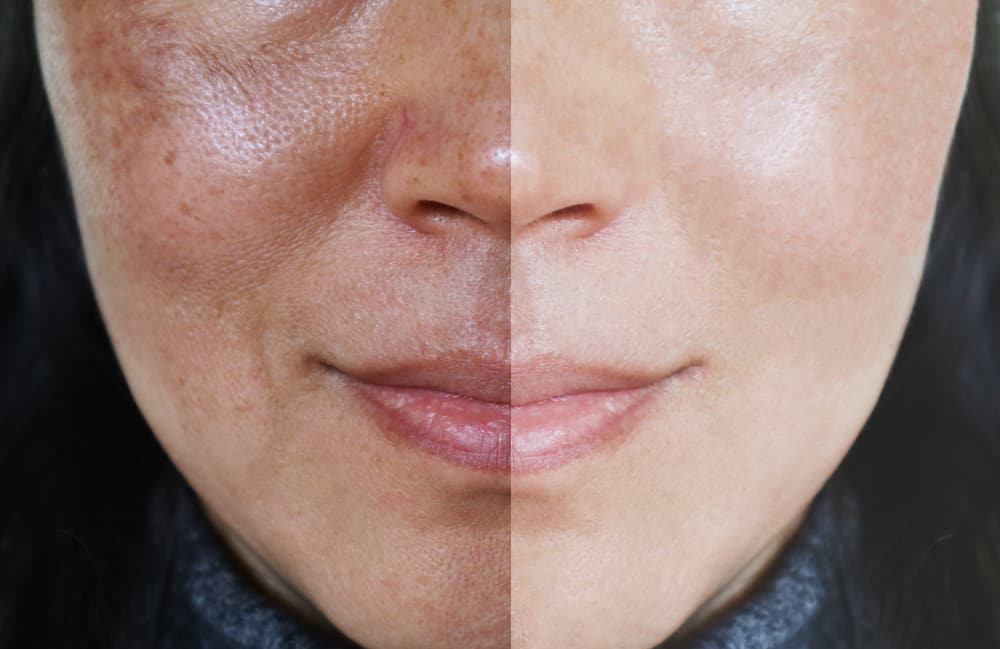Melasma (muh-LAZ-muh) is a very common skin problem that causes brown to gray-brown patches on the face with sun exposure. It is most common in women and can affect the skin of the cheeks, nose, forehead, chin, and upper lip — typically in a distinctive pattern. It also can appear on other parts of the body that get lots of suns, such as the forearms and neck.
The cause of melasma remains unknown but clearly hormonal factors and exposure to sunlight are critical to the development of melasma. Melasma can occur without hormone pills or pregnancy — only 25% of women report melasma occurring after starting an oral contraceptive pill. Thus melasma can occur with normal or endogenous levels of the hormone. Melasma should be considered a chronic disorder that in many patients lasts for years.
Melasma is a disorder of the pigment-producing cells in our skin called melanocytes. Melanocytes are called dendritic cells and resemble what we might think of like an octopus shape with a central body and long tentacles or fingers stretching out from the central body. These tentacles or fingers of the melanocytes deposit pigment or melanin into the upper layer of our skin, the epidermis. The pigment is stored in small particles called melanosomes. Melasma-affected skin has increased melanocytes and melanocytes with more numerous dendrites or tentacles/fingers. Melanocytes of melasma-affected skin also show evidence of being more biologically active than melanocytes in normal or unaffected skin.
Some melasma has more pigment in the deeper skin layer or dermis where the pigment is no longer in the melanocytes but in another cell called the melanophage which is an inflammatory cell trying to remove pigment. This pigment in the deeper layer of skin may explain why melasma is so difficult to eradicate.
It is still not known why certain areas of the face are predisposed to developing melasma while others are not involved. Hormone receptors, blood vessels, stem cell factors, and cutaneous nerves may play a role.
Melasma is uncommon in males. Additionally, it is thought to be primarily related to external sun exposure, external hormones like birth control pills, and internal hormonal changes as seen in pregnancy.
Most people with melasma have a history of daily or intermittent sun exposure, although heat is also suspected to be an underlying factor. Melasma is most common among pregnant women, especially those of Latin and Asian descent. People with olive or darker skin, like Hispanic, Asian, and Middle Eastern individuals, have higher incidences of melasma.
This skin condition can be prevented. If you avoid it, you don’t have to worry about melasma treatment prices in Indonesia. Melasma can be prevented with regular sunscreen application, and medications such as fading creams.
Treatment of melasma is very challenging and even with excellent results from a treatment, the pigment of melasma can and very often does recur. If melasma develops after starting a hormone pill, it is recommended that the pill be stopped and all similar hormonal pills are avoided in the future; however, it is the experience of many melasma sufferers that the discoloration persists even after stopping all hormones.
Sun block and Sun Protection:
The most basic and essential part of any treatment regimen for melasma is daily -every single day, even on cloudy days.
Patients who wish to treat their melasma should employ additional methods of sun protection including avoiding the sun as much as possible during the peak hours of the day, wearing a hat (and sun protective clothing if you have melasma on the arms or chest), and seeking shade whenever possible.
Because melasma is a disorder of pigmentation, topical products that block the process of pigment production are helpful in the treatment of melasma. Pigment production is a complex process and there are many products that act at different steps in this process. No one product is 100% successful at preventing and treating pigment so often multiple different products are used as they all work at different steps in the process.
Retinoids:
Retinoic acid and its derivatives (Retin-A, tretinoin, retinol, adapalene, tazarotene) have been shown to reduce the pigment of melasma and sun damage. They act by stimulating skin cell or keratinocyte turnover, decreasing the transfer of pigment to skin cells and enhancing penetration of other active ingredients. Additionally, retinoids are an essential part of an anti-aging skin care regimen as they act to block the breakdown of collagen in the skin upon sun exposure.
Ascorbic Acid or Vitamin C:
In addition to being a powerful antioxidant, Vitamin C in skin serums and creams can block copper where it interacts with tyrosinase. Antioxidants are a critical part of any anti-aging program as they prevent oxidative injury to the skin with sun exposure.
Chemical Peels
Chemical peels may improve or reduce the appearance of pigment in the skin from melasma, sun damage, acne, rashes, or other blemishes. Because these peels can also cause some irritation, they must be used with caution and at lower strengths in patients with darker skin. Irritation or poor wound healing from a peel can cause hyperpigmentation or darkening which is called post-inflammatory hyperpigmentation.
Lasers:
A number of different lasers have been used in the treatment of melasma and, like the topical agents and chemical peels, none of them work perfectly. There is a very small risk of worsening melasma or increased darkening after laser treatments and even in cases where the melasma fades beautifully after laser, it is very much prone to coming back.
At Lumina Aesthetics Clinic we have had a new treatment with low energy, short-pulsed (q-switched) 1064nm laser is replacing other laser treatments for melasma because of it’s gentle, non-irritating effect which gives increased safety and efficacy. This targets the melanosome the tiny storage package of pigment in the skin.
It is critical to of the treatment plan and not abandon the treatments recommended on the bottom levels — sun protection and topical agents — even if chemical peels or laser treatments are started. Melasma should be viewed as a chronic condition similar to high blood pressure where control can be obtained but not a cure.
Melasma is a very challenging condition to treat and manage. At Lumina Aesthetics Clinic, we have helped many patients improve their melasma and maintain healthier skin even if a permanent cure cannot be obtained.






